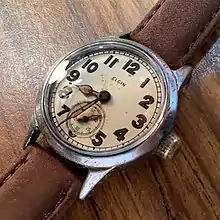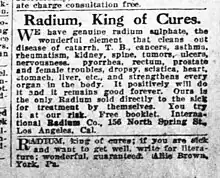Radium dial
Radium dials are watch, clock and other instrument dials painted with luminous paint containing radium-226 to produce radioluminescence. Radium dials were produced throughout most of the 20th century before being replaced by safer tritium-based luminous material in the 1970s and finally by non-toxic, non-radioactive strontium aluminate–based photoluminescent material from the middle 1990s.

History

Radium was discovered by Marie and Pierre Curie in 1898[1] and was soon combined with paint to make luminescent paint, which was applied to clocks, airplane instruments, and the like, to be able to read them in the dark.[2]
In 1914, Dr. Sabin Arnold von Sochocky and Dr. George S. Willis founded the Radium Luminous Material Corporation. The company made luminescent paint. The company later changed its name to the United States Radium Corporation. The use of radium to provide luminescence for hands and indices on watches soon followed.
The Ingersoll Watch division of the Waterbury Clock Company, a nationally-known maker of low-cost pocket and wristwatches, was a leading popularizer of the use of radium for watch hands and indices through the introduction of their "Radiolite" watches in 1916.[3] The Radiolite series, made in various sizes and models, became a signature of the Connecticut-based company.
Radium dials were typically painted by young women, who used to 'point' their brushes by licking and shaping the bristles prior to painting the fine lines and numbers on the dials. This practice resulted in the ingestion of radium, which caused serious jaw-bone degeneration and malignancy and other dental diseases. The disease, radium-induced osteonecrosis, was recognized as an occupational disease in 1925 after a group of radium painters, known as the Radium Girls, from the United States Radium Corporation sued. By 1930, all dial painters stopped pointing their brushes by mouth. Stopping this practice drastically reduced the amount of radium ingested and therefore, the incidence of malignancy.
Luminous Processes employees interviewed by a journalist in 1978 stated they had been left ignorant of radium's dangers. They were told that eliminating lip-pointing had ended earlier problems. They worked in unvented rooms, they wore smocks that they laundered at home. Geiger counters could pick up readings from pants returned from a dry cleaner and from clothes stored away in a cedar chest."[4]
Safety


According to the United States Environmental Protection Agency, "radioactive antiques [including watches] are usually not a health risk as long as they are intact and in good condition."[5] However, radium is highly radioactive, emitting alpha, beta, and gamma radiation — the effects of which are particularly deleterious if inhaled or ingested since there is no shielding within the body.[5] Indeed, the body treats radium as it does calcium, storing it in bone where it may cause bone degeneration and cancer.[5]
Therefore, it is of the utmost importance that watches with radium dials should not be taken apart[5] without proper training, technique, and facilities. Radium paint can be ingested by inhaling flaking paint particles. The alpha particles emitted by the radium, which is taken up in bone, will kill off surrounding bone tissue, resulting in a condition loosely referred to as radium jaw. Inhaled or ingested particles may deposit a high local dose with a risk of radiation-caused lung or gastrointestinal cancer. Penetrating gamma radiation produced by some dials also represents a significant health risk.
Although old radium dials generally no longer produce light, this is due to the breakdown of the crystal structure of the luminous zinc sulfide rather than the radioactive decay of the radium. The radium isotope (226Ra) used has a half-life of about 1,600 years,[6] so radium dials remain essentially just as radioactive as when originally painted 50 or 100 years ago, whether or not they remain luminous.
Radium dials held near the face have been shown to produce radiation doses in excess of 10 µSv / hour. After about 20 minutes this delivers the equivalent of one whole day's worth of normal background radiation. This rate probably only represents the dose rate from gamma emission, as the alpha emission will be stopped by the lacquer, or crystal, or case; hence, the dose rate following ingestion or inhalation of the dust could be much higher.
Chronic exposure to high levels of radium can result in an increased incidence of bone, liver, or breast cancer.[6] Decaying radium also produces the gas radon, recognized as the second leading cause of lung cancer in the United States[6] and the United Kingdom.[7] A 2018 study by researchers from the University of Northampton found that a collection of 30 vintage military watches with radium dials kept in a small, unventilated room produced a radon concentration 134 times greater than the UK's recommended "safe" level.[7]
Ingestion of radium has been linked to anemia, cataracts, broken teeth, and reduced bone growth.[8]
Regulation

In the United States there does not seem to have ever been prohibitory legislation passed banning the use of radium in clocks and watches. It was only with the passage of the Energy Policy Act of 2005 that the United States Nuclear Regulatory Commission (NRC) was given oversight of the use of radium.[9] Prior to that date, "the federal government had a limited role, if any, in ensuring the safe use of radium," according to the NRC.[9] The element was phased out of use by industry acting under its own volition as superior and safer luminous materials entered the marketplace.
Brands
- Undark produced by the United States Radium Corporation
- Luna produced by the Radium Dial Company
- Marvelite produced by the Cold Light Manufacturing Company (a subsidiary of the Radium Company of Colorado)
See also
Footnotes
- "Radioactivity : Radium". www.radioactivity.eu.com. Retrieved 2022-03-22.
- "RadTown". 21 June 2017.
- "Which of These Two Are You?" (ad) New York Tribune, May 24, 1916, p. 6.
- Claudia Clark, The Radium Girls. (ISBN 978-0-8078-4640-7)
- "Radioactivity in Antiques," United States Environmental Protection Agency, www.epa.gov, accessed June 6, 2022.
- "Radionuclide Basics: Radium," United States Environmental Protection Agency, www.epa.gov, accessed June 6, 2022.
- "WWII Military Watches 'Potentially Pose Serious Cancer Risk,' Faculty of Arts, Science, and Technology, University of Northampton, www.northampton.ac.uk/ June 14, 2018.
- "Health Effects of Radium Radiation Exposure," Massachusetts Department of Public Health, mass.gov/, accessed June 7, 2022.
- "Radium," United States Nuclear Regulatory Commission, www.nrc.gov/, June 19, 2021.
Further reading
- Jane Brickman, "Radium Girls: Women and Industrial Health Reform, 1910–1935," Journal of Public Health Policy, v. 21, no. 2 (June 2000), pp. 245–247.
- Kate Moore, The Radium Girls: The Dark Story of America's Shining Women. Naperville, IL: Sourcebooks, 2018.
External links
- Joe Baron, "Watches and Radiation Risk," Watchprozine.com, Nov. 9, 2015.
- Kathleen McGivney, "How I Learned to Stop Worrying and Love Radium Dials," [Video] Horological Society of New York via YouTube, Nov. 7, 2017. —Talk starts at 6:08.
- Precision Watches, "Lume 101: Watch Luminescence Explained," Precisionwatches.com, captured June 6, 2022.